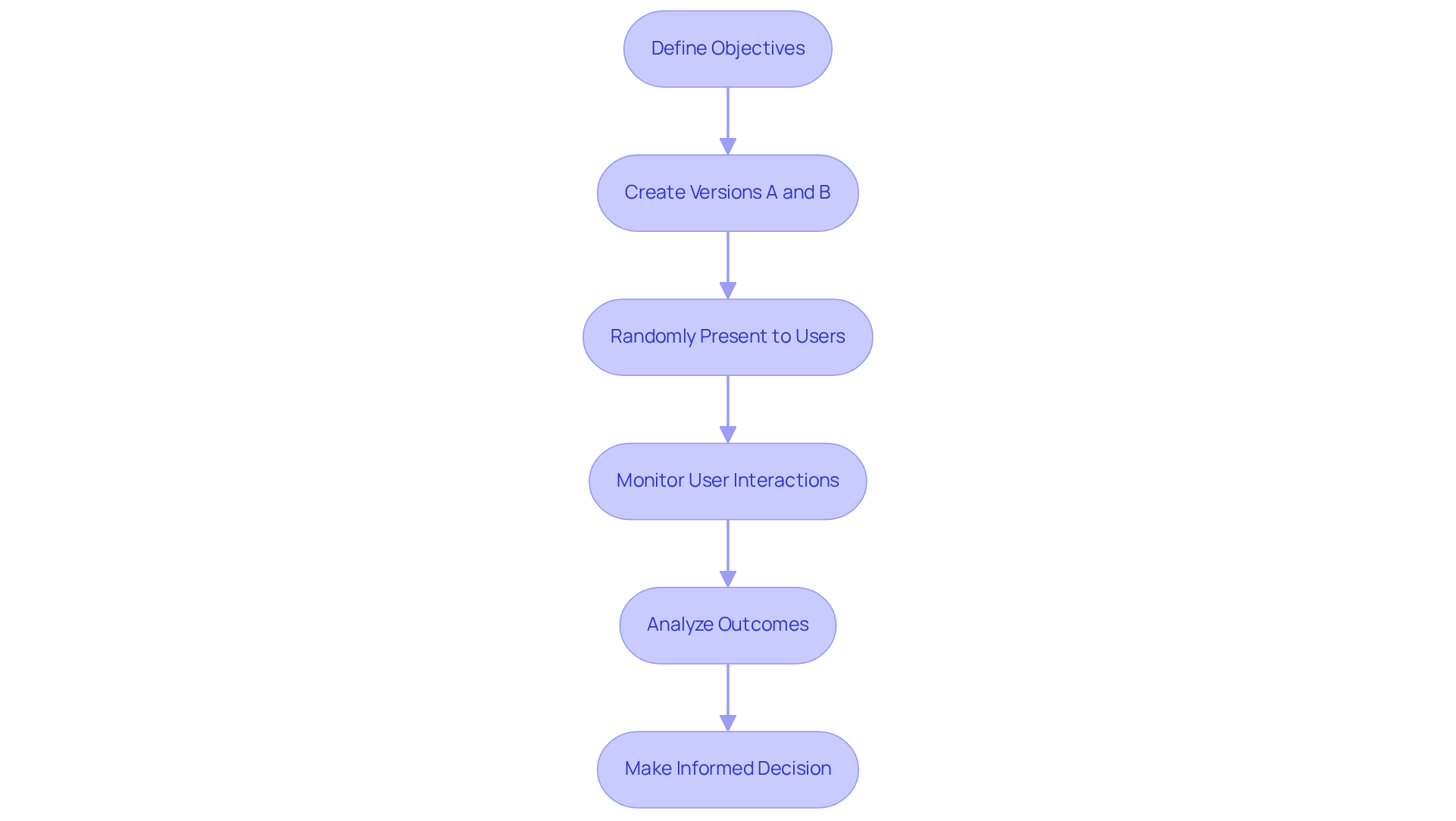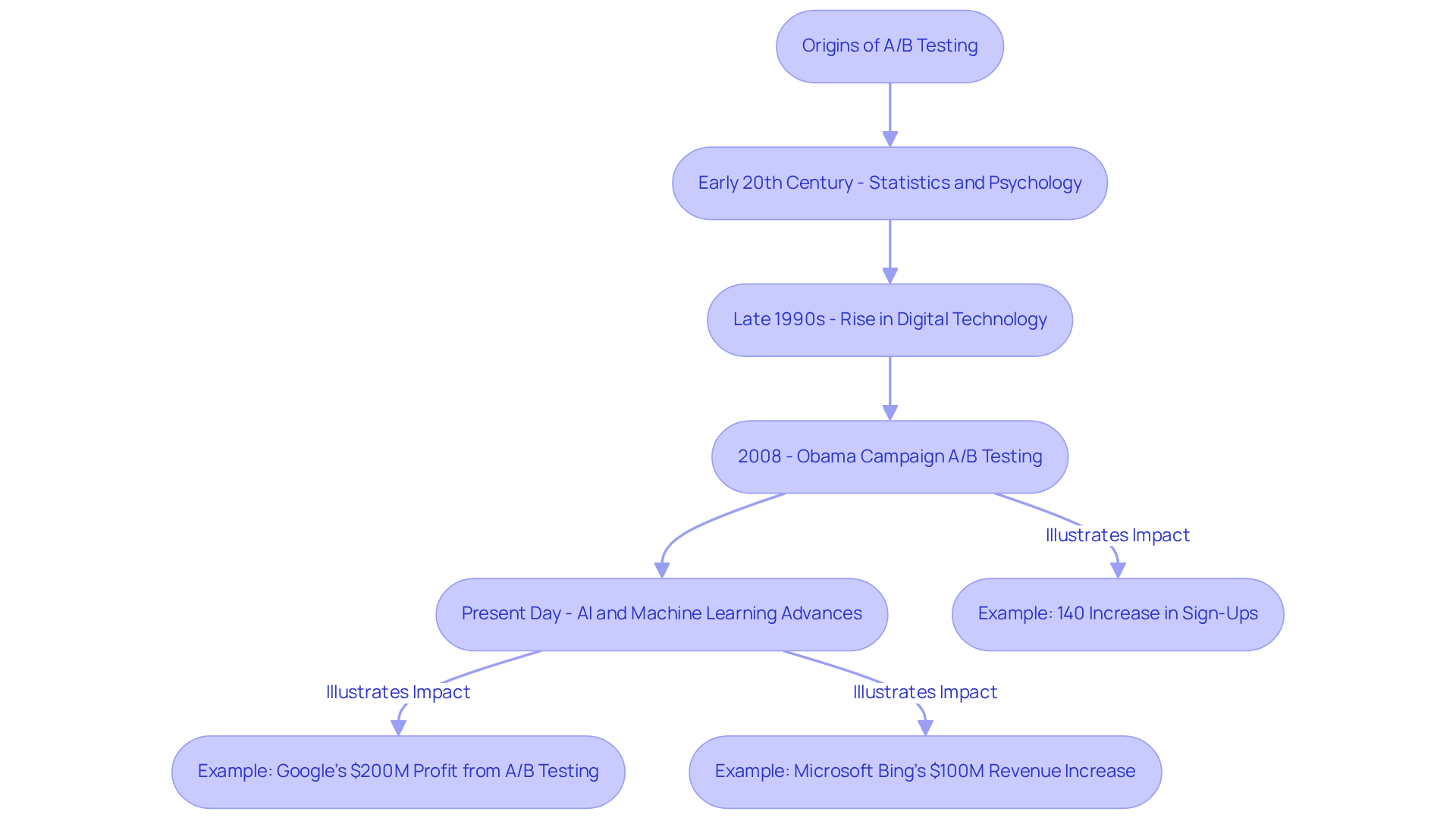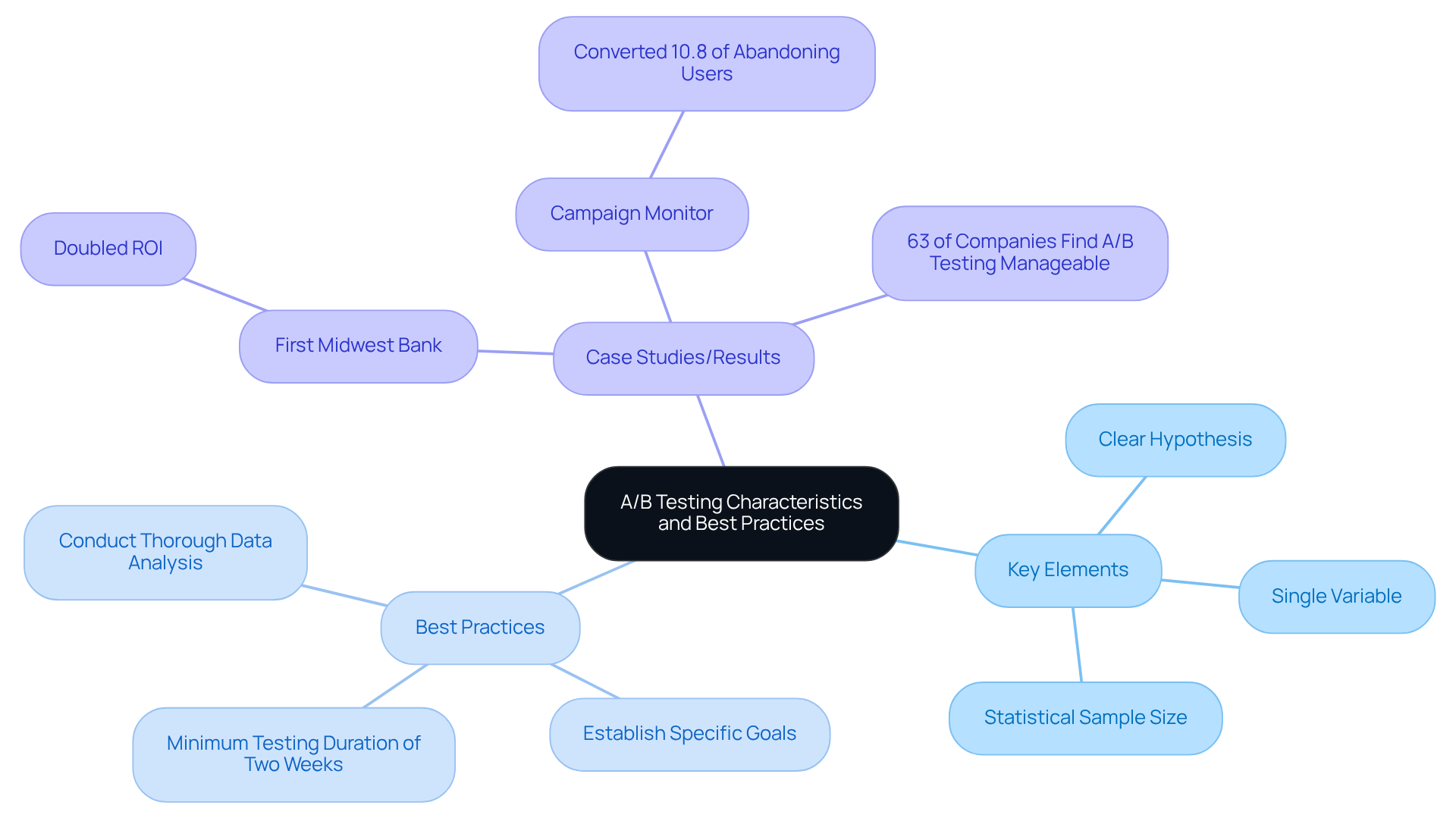
Overview
A/B testing is a pivotal method in digital marketing, designed to compare two versions of a webpage or app to ascertain which one excels in achieving specific objectives, such as enhancing conversion rates. This article underscores its significance by presenting compelling case studies and statistics that illustrate how A/B testing fosters informed decision-making and drives substantial revenue growth for businesses. By optimizing user experiences, A/B testing emerges as an essential strategy for organizations aiming to thrive in a competitive landscape.
Introduction
A/B testing stands as a cornerstone of digital marketing, empowering businesses to make data-driven decisions that significantly enhance user engagement and conversion rates. By comparing two versions of a webpage or marketing asset, organizations can uncover insights that lead to optimized strategies and improved performance. As the landscape of consumer behavior continues to evolve, brands must effectively leverage A/B testing to stay ahead of the competition and maximize their impact.
Define A/B Testing: Understanding the Basics
A/B testing, often referred to as split evaluation, is a strategic method utilized in digital marketing to compare two versions of a webpage, app, or marketing asset. The primary objective is A/B testing to determine which variant is the most successful in achieving specific goals, such as enhancing conversion rates. A/B testing involves presenting two versions—labeled A and B—randomly to users, while meticulously monitoring their interactions to ascertain which version delivers superior outcomes.
This empowers businesses to make informed decisions based on actual user behavior rather than mere assumptions. Notably, companies like Bing have reported revenue increases ranging from 10% to 25% attributable to A/B experimentation, underscoring its potential impact on profitability. Furthermore, successful A/B experiments abound; for instance, the Obama campaign raised $75 million through the optimized evaluation of various campaign components, culminating in a remarkable 140% increase in website sign-ups.
Statistics reveal that approximately 77% of companies recognize A/B testing as essential for enhancing conversion rates on their websites. Experts assert that A/B testing is crucial for improving marketing effectiveness, with 60% of companies acknowledging its importance in boosting conversion rates. By leveraging A/B trials, businesses can refine their strategies, optimize user experiences, and ultimately drive significant growth.

Contextualize A/B Testing for DTC Brands: Importance and Applications
For direct-to-consumer (DTC) companies, understanding A/B testing can serve as a pivotal method for enhancing customer engagement and driving revenue growth. In an environment characterized by escalating customer acquisition costs, it is imperative for companies to seize every opportunity to improve conversion rates. A/B testing can be effectively applied across multiple touchpoints, including landing pages, email campaigns, and product pages. This approach allows companies to refine their messaging, design, and overall user experience.
By systematically evaluating various elements—such as headlines, images, and calls to action—DTC companies can leverage A/B testing to uncover valuable insights into what resonates most with their audience. A notable study indicates that 70% of online shoppers believe product content significantly influences their purchasing decisions, highlighting the critical nature of effective messaging.
Furthermore, successful case studies exemplify the tangible benefits of A/B testing. For instance, Parah Group aided a $30M clothing label in achieving a 35% increase in conversion rates by redesigning their homepage to highlight social proof and optimizing product pricing. Similarly, a $15M cleaning product label experienced an 80% rise in average order value (AOV) after implementing strategic A/B tests on their pricing and product bundling. These instances demonstrate how A/B evaluation not only enhances engagement but also drives substantial sales growth for DTC companies.
As companies integrate A/B experimentation into their regular practices rather than treating it as a one-off initiative, they can continually refine their strategies based on actual user data. Establishing clear, measurable goals—such as increasing $200+ orders by 7% within a month—should be emphasized as a best practice to guide these efforts. Ultimately, A/B experimentation empowers DTC brands to make informed decisions that lead to and increased revenue.

Trace the Origins of A/B Testing: Evolution and Historical Significance
[A/B experimentation](https://parahgroup.com) has its origins in the early 20th century, where its principles were first applied in the realms of statistics and experimental psychology. This methodology gained significant traction within the business sector with the rise of digital technology, particularly during the late 1990s and early 2000s, as online enterprises aimed to optimize their websites for improved performance. The surge of e-commerce and the increasing accessibility of user data propelled A/B analysis into standard marketing practices. Today, it stands as a fundamental element of , empowering brands to make evidence-based decisions that foster growth.
A/B experimentation, also known as ab testing what is, is a prevalent method for gathering data in online environments, with 77% of organizations conducting A/B experiments on their websites. Experts emphasize that ab testing what is has a transformative impact on promotional strategies. For example, the Obama campaign's implementation of A/B analysis in 2008 resulted in an extraordinary 140% increase in website sign-ups, illustrating the potency of data-driven decisions in political marketing. Similarly, leading technology firms like Google and Microsoft have integrated A/B evaluations into their core operations, executing thousands of assessments annually to enhance user experiences and optimize engagement. Notably, Google's A/B experiment involving 41 shades of blue generated $200 million in profits, showcasing the financial implications of A/B analysis.
As this approach continues to evolve, advancements in artificial intelligence and machine learning are expected to further refine ab testing what is used in evaluation methods, facilitating more personalized and efficient promotional strategies. Moreover, the multi-armed bandit approach is projected to gain mainstream acceptance by 2025, particularly benefiting sectors such as eCommerce and SaaS. Ethical considerations are also becoming increasingly relevant due to evolving data privacy regulations like CCPA and GDPR, prompting companies to adapt their A/B evaluation processes. A/B experimentation is forecasted to generate up to $1.08 billion in revenue by 2025, underscoring its growing significance in the marketing landscape.

Identify Key Characteristics of A/B Testing: Methodologies and Best Practices
Ab testing is characterized by several key elements:
- A clear hypothesis
- The selection of a single variable for evaluation
- The use of a statistically significant sample size, typically requiring at least 25,000 visitors for reliable results
Best practices dictate that specific goals be established for each test, ensuring that the variants are sufficiently distinct to yield meaningful insights. Thorough data analysis is essential for deriving actionable conclusions. Moreover, tests should be conducted over a minimum of two weeks to effectively capture variations in user behavior. By adhering to these methodologies, brands can significantly enhance their A/B evaluation efforts.
Case studies illustrate this point, with firms like First Midwest Bank doubling their ROI through innovative experimentation strategies. Furthermore, industry insights reveal that 63% of companies find A/B testing manageable, underscoring its accessibility. Ultimately, the implementation of these best practices can lead to substantial improvements in conversion rates, with by as much as 400%.

Conclusion
A/B testing stands as a cornerstone of data-driven decision-making in the digital marketing landscape. This method not only allows businesses to compare different versions of their marketing assets but also empowers them to make informed choices that enhance user engagement and drive conversion rates. By leveraging A/B testing, companies can move beyond intuition and assumptions, relying instead on concrete evidence gathered through user interactions.
The article highlights several critical aspects of A/B testing, including its definition, historical context, and key characteristics. It emphasizes the significance of A/B testing for direct-to-consumer brands, showcasing how strategic implementation can lead to substantial increases in conversion rates and overall revenue. Notable case studies illustrate the tangible benefits of A/B experimentation, reinforcing its role in optimizing marketing effectiveness and user experience.
In light of the insights presented, it is clear that A/B testing is not merely a tactic but a vital strategy for brands aiming to thrive in a competitive market. As businesses continue to evolve and adopt more sophisticated methodologies, embracing A/B testing will be essential for achieving sustained growth and maximizing marketing ROI. Companies are encouraged to integrate A/B testing into their ongoing practices, setting measurable goals and adapting their strategies based on real user data to unlock their full potential.
Frequently Asked Questions
What is A/B testing?
A/B testing, or split evaluation, is a method used in digital marketing to compare two versions of a webpage, app, or marketing asset to determine which one is more successful in achieving specific goals, such as improving conversion rates.
How does A/B testing work?
A/B testing involves presenting two versions, labeled A and B, to users randomly and monitoring their interactions to see which version produces better outcomes.
Why is A/B testing important for businesses?
A/B testing allows businesses to make informed decisions based on actual user behavior rather than assumptions, helping to optimize strategies and improve marketing effectiveness.
What impact can A/B testing have on revenue?
Companies that utilize A/B testing have reported revenue increases ranging from 10% to 25%, highlighting its potential to significantly impact profitability.
Can you provide an example of successful A/B testing?
The Obama campaign raised $75 million through optimized evaluation of various campaign components, resulting in a 140% increase in website sign-ups.
How many companies consider A/B testing essential?
Approximately 77% of companies recognize A/B testing as essential for enhancing conversion rates on their websites, with 60% acknowledging its importance in improving marketing effectiveness.
FAQs











